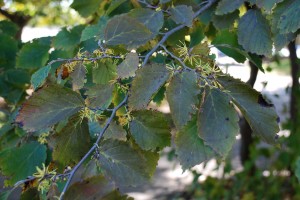American witchhazel (Hamamelis virginiana) is the last native flowering plants to bloom in the calendar year. It is a deciduous shrub or small tree, native to woodlands, forest margins and stream banks in eastern North America (USDA hardiness zones 3-8). It typically grows 15-20 feet tall as a multi-stemmed shrub and 30 feet tall in tree form.
Beginning in late September (in Tennessee), branches are covered with tiny clusters of bright yellow flowers. Each flower is composed of 4 strap-like yellow petals. In some years flowers appear before leaf drop and some flowers go unnoticed.
The fertilized flowers form greenish seed capsules that mature to light brown almost a full year later. Seed capsules split open next fall, nearly a year later, and blast (dehisce) seeds 10-20 feet away. Obovate (oval) witchhazel leaves are dark green and average 6 inches in length. Foliage may turn many shades of yellow in fall.
American witchhazel grows in an average, moist, well-drained, mildly acidic soil and in full sun to partial shade. Growing preference is light shade to partial sun and in sandy loam soil. More flowers are produced in full sun than shade. It tolerates compacted and clay soil, but tends to sucker freely to eventually form thickets or colonies; remove suckers to maintain a tidy appearance. Otherwise, little pruning is necessary other than to limit plant height and spread. Pruning is best scheduled for early spring.
Cultivars: There are only a few known selections of American witchhazel. In a trial of various witchhazel clones, Dr. Andrew Bell at the Chicago Botanical Gardens, singled out ‘Little Suzie’ and ‘Harvest Moon’. Both are compact growers and produce abundant flowers. Little Suzie is more dwarf in stature. Harvest Moon drops its foliage early to show off its lemony yellow flowers.


 Posted in
Posted in 
